This ruling was made because of events that took place on September 27, 2019, when 123 juvenile Giant Tortoises went missing from the Arnaldo Tuiza Breeding Centre on Isabela Island.
In a press release, the Attorney General’s Office of Ecuador (FGE), stated that investigations revealed that tortoises taken from the breeding centre were systematically replaced by wild tortoises. This was in addition to the fact that illegal sales of these reptiles were apparently occurring in Ecuador and Peru.
The court imposed a minimum of 10 monthly wages, sold assets and bank accounts totaling $4,000 and a total $669,000 as restitution to Galapagos National Park Directorate. The three other defendants in the case, Daniel T. T. and Gustavo F. G., were also found innocent.
Galapagos Conservancy supports the GNPD in its fight against wildlife trafficking. Protecting the Galapagos Islands’ unique species is vital for the survival of the Archipelago.
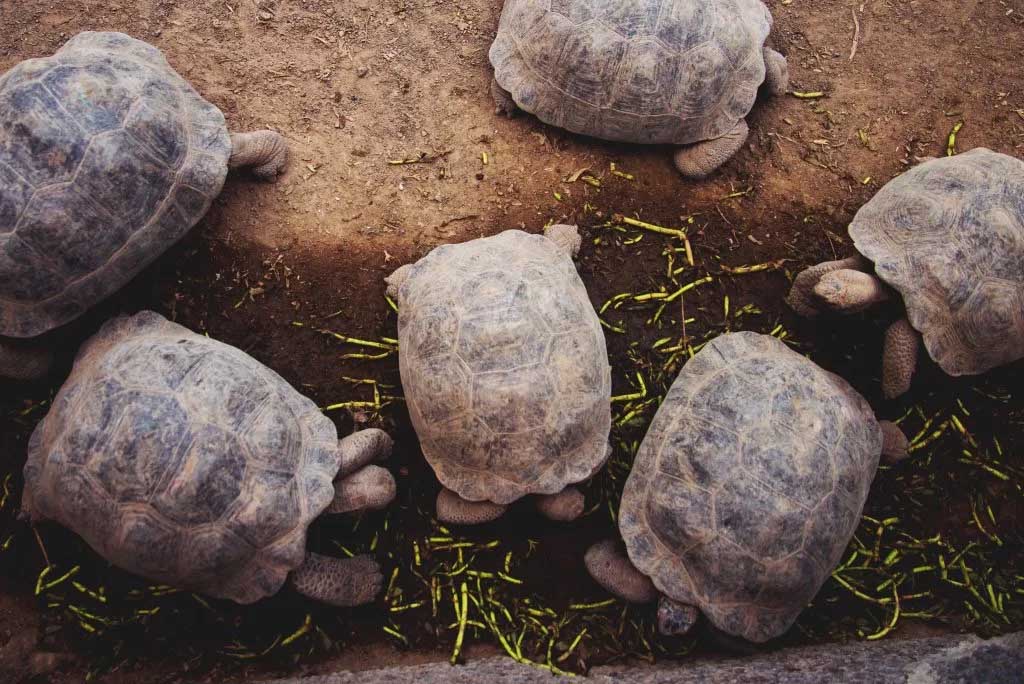
Galápagos Giant Tortoises © Joshua Vela
One of the most well-known crustaceans of the Archipelago is the Spiny Lobster, which can be found in the waters of Galapagos Marine Reserve. The Galapagos Coral Reefs are home to two species: the Red Spiny Lobster and the Green Lobster. They can also be found in restaurants during certain months.
These clawless, nocturnal crustaceans can be identified by their spiny shells, long antennae, and thick, thick antennae. The hard, fibrous substance called Chitin protects their bodies. This natural protective shell does not expand so lobsters have to shed their shells as they grow. Young lobsters may molt multiple times per year, while adults only molt once or twice per year.
Lobsters are important as purifiers and keystone predators in marine ecosystems. Their conservation is crucial for other species. Spiny Lobsters also provide other services, including the feeding of Sea Urchins. Sea Urchins can become too dependent on kelp and coral reefs, which are the main food sources for Galapagos Marine Iguanas.
Climate change has also had an impact on Spiny Lobster populations. Sea level rises and temperature increases have threatened the survival and recruitment of this species. The coastal marine habitat has also been affected by human activities, which together with overfishing has led to a decline in lobster catches and population size.
The economy of Galapagos is also dependent on the Spiny Lobster. The Galapagos National Park Directorate, (GNPD), evaluates the population status in the Archipelago each year to determine the appropriate management actions. They also supervise the fishing using strict measures according to the fishing calendar established by the environmental authority.
This fishing can be done every year, but only when the weather is favorable. It usually takes place between September and December. Galapagos visitors can enjoy the local delicacy of lobster, which is capable of surprising even the most discerning palates, during lobster season.
Galapagos’ ecosystems are dependent on marine and coastal environment protection. Galapagos Conservancy, together with Conservando Galapagos, congratulate the GNPD on their decades-long efforts to protect the marine resources of Galapagos.
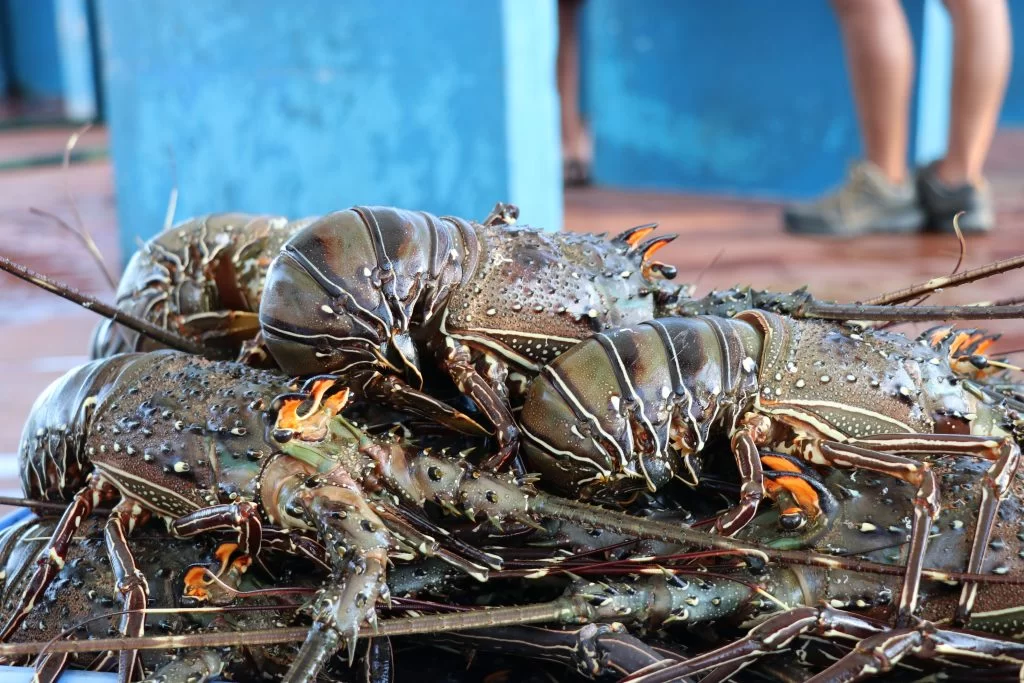
Spiny Lobster © GNPD
Invasive species pose a threat to ecosystems and wildlife in Galapagos. Invasive insects can be tiny, but they are powerful invaders. Inadvertently, the avian Vampire Fly was introduced to Galapagos in 1960s. It was introduced onto poultry. It is now widespread in the Islands. Its bloodsucking larvae kill and maim most small landbird species. Introduced Fire Ants can also attack ground-dwelling species and even tortoise hatchlings.

Fire Ant © Galápagos National Park Directorate
Blackberry and Guava, invasive plants, overtake ecosystems and choke native plants. Other species are also affected by invasive plants like Blackberry and Guava. This includes insects that pollinate native plant species, birds such as the Vermillion Flycatcher, which require open habitats without invasive plants to forage, as well the reptiles of Galapagos, like tortoises, that depend on native plants for their food.
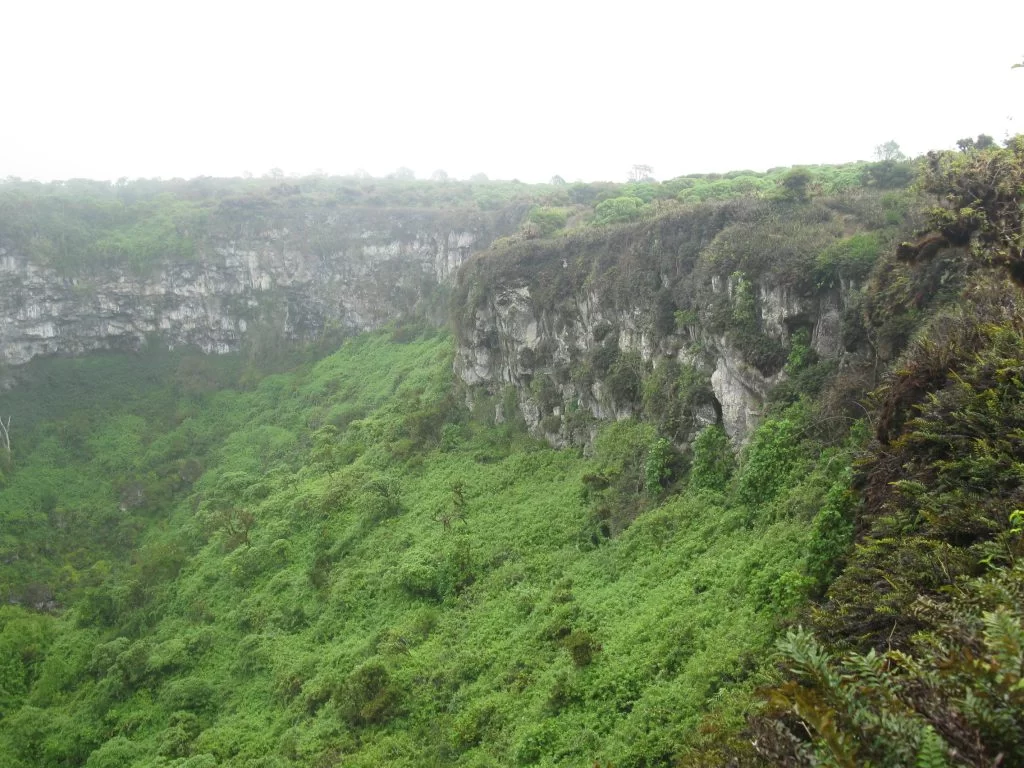
Blackberry groundcover at Los Gemelos © Joshua Vela/Galápagos Conservancy
My pet cat is my best friend at home. But in Galapagos introduced feral cats can become formidable predators. They can eat small birds, young tortoises and Lava Lizards. This can lead to rapid population declines. Adult Land Iguanas have suffered the most from free-roaming dogs on many of their islands. Canine distemper is also a problem for dogs and can pose a serious threat to beach-dwelling Sea Lions. Galapagos Conservancy promotes responsible pet ownership in the Islands through a partnership with WorldVet. This allows for sterilization and vaccination of cats and dogs.
Galapagos’ most destructive invasive mammal, the Black Rat, has been known to be an ecosystem-destroyer worldwide. These rodents eat tortoise eggs, birds eggs, native insects, as well as seeds from many plants. Native species are at risk of extinction from invasive rats: With only 20-30 Mangrove Finches left today, this species is considered Critically Endangered. This may partly be due to cats and rats attacking their nests. Black Rats have largely driven the native Rice Rats, and their endemic snails, to extinction.
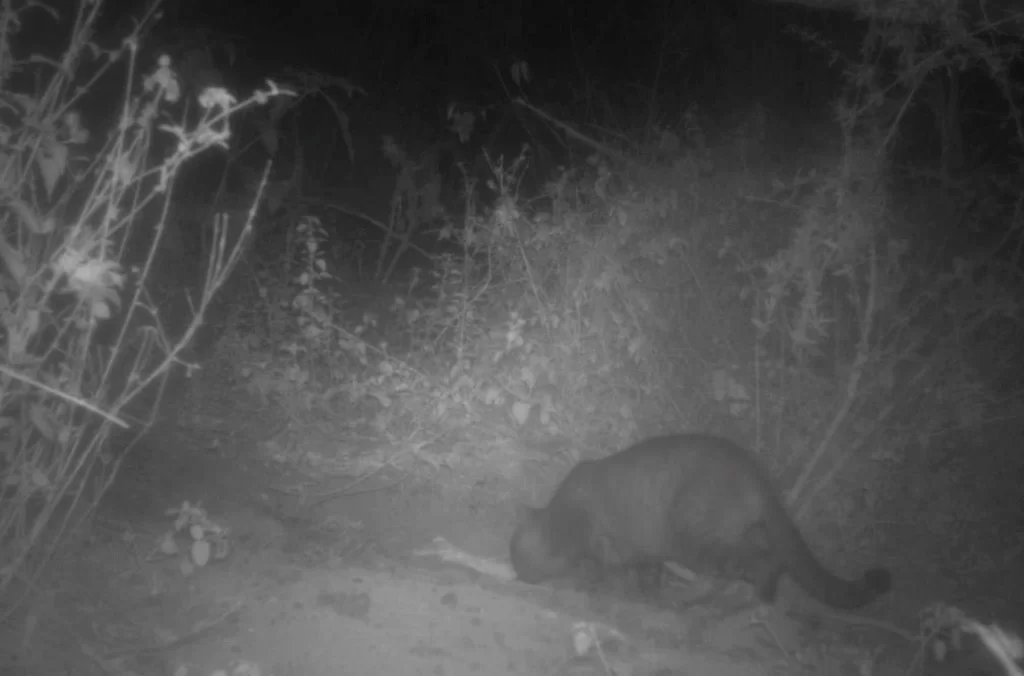
Feral cat caught on wildlife camera © Galápagos Conservancy
Galapagos Conservancy supports the Agency for the Regulation and Control of Biosecurity and Quarantine for Galapagos for five years. This agency conserves biodiversity by responding to the spread of invasive species and diseases that are transmissible to humans and wildlife. These agencies do amazing work and benefit from Galapagos Conservancy’s critical funding to address emergencies.
Galapagos Conservancy and ABG will continue to fight for the preservation of Galapagos from invasive species. They are like the amazing people I know in the U.S. clearing the prairies of invasive Buckthorn, and saving the American Chestnut from near extinction.
The teachers were enthusiastic about learning from each other and showed a strong desire to improve their teaching skills. Lenin Rogel (Coordinator of the Education for Sustainability Program) said that he was pleased by the enthusiasm of the teachers and his gratitude for the U.S. government’s support and endorsement of the Ministry of Education for this important effort to improve education in Galapagos.
Jenny Yepez, a teacher from Miguel Angel Cazares Educational Unit, spoke highly of the training’s impact, saying that it was a “fruitful” experience that gave her new strategies and techniques she could use in her classroom. Carmen Cajamarca (one of the trainers) said the same thing, adding that it was an opportunity to share best practices and learn from others in sustainability education.
Galapagos Conservancy wishes to extend warm congratulations to all the teachers. We remain committed to supporting education and sustainability in Galapagos for the benefit its people, wildlife and ecosystems.
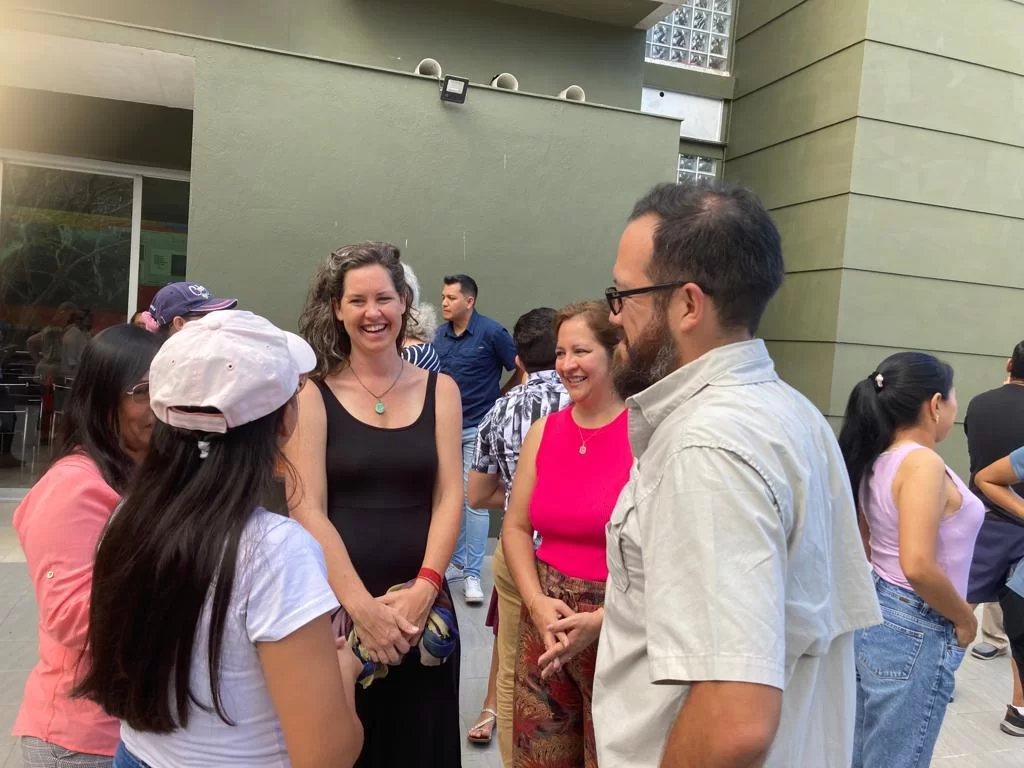
Teachers at the English teaching training session in San Cristóbal Island © Galápagos Conservancy
Satellite tracking is one technology being used to study the Galapagos Islands’ Giant Tortoises. Scientists can attach GPS devices to the shells of tortoises and track their movements and activities, which provides critical information that will help in the management and conservation of these rare animals.
Scientists can now study the Alcedo Volcano Giant Tortoises of Isabela Island using this technology without needing to spend too much time on the volcano. Satellite tracking data is crucial for the management of this population. It is used to answer key questions regarding the movements and habitat use of the tortoises.
These GPS devices are approximately 3×3 inches in size and can be attached to tortoises shells. These GPS devices are the most recent in satellite tracking technology, and they weigh only 200g, so they don’t have any effect on tortoises,” Washington Tapia, General Director at Galapagos Conservancy, and Conservando Galapagos, said.
Satellite tracking and other management actions are crucial for Giant Tortoise restoration and conservation. Alcedo Volcano Giant Tortoises currently numbers approximately 10,000. This makes it the island’s largest tortoise colony. The successful management programs such as the 2006 eradication and permanent feeding of donkeys and goats have helped to restore the vegetation.
It takes significant time and effort to implement and maintain conservation measures for Giant Tortoises who live on the Alcedo Volcano, which is remote and difficult to access. Galapagos Conservancy is grateful for the support that has been given to these efforts to save and restore Galapagos’ iconic Giant Tortoises.
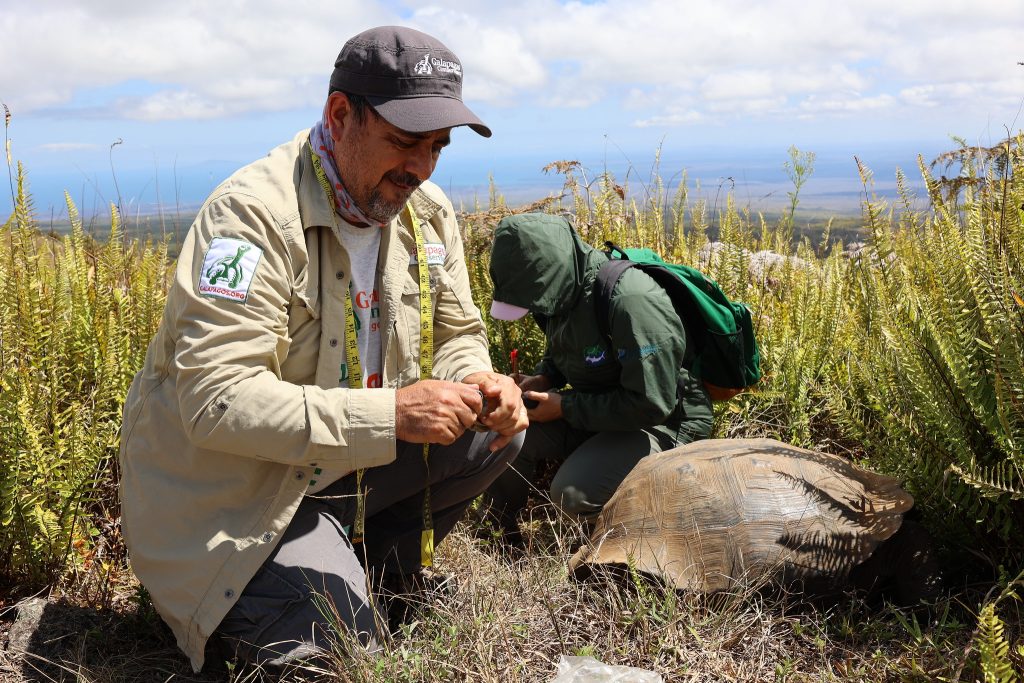
Washington Tapia on mission to attach Satellite Tracking Devices © Galápagos Conservancy
Director of Galapagos National Park Danny Rueda noted that the pilot project will be a benefit to ecosystems and local productive sector by regenerating areas with high ecological value. Rueda explained that coral helps to capture CO2 and transform it into oxygen for various species coexisting within marine ecosystems. It also serves as a seedbed of fish and other marine resources valuable to artisanal fishermen in Galapagos, which provides economic and social benefits.
The project was started in 2020. However, Galapagos Conservancy support has since February 2022 made it significantly stronger and yielding very promising results. A nursery currently grows 323 coral fragments from the 8 species of corals that have been planted. It has four planting beds.
Jennifer Suarez is a GNPD project leader, and a park ranger. According to Jennifer Suarez Pocillopora corals grow at a faster pace than other species with an average growth rate of around one inch per month. The average growth rate for Pocillopora corals was 20 mm per mois, while the average monthly growth rate was 43 mm. These averages were calculated using data prior to La Nina in 2021.
Jennifer said that corals can provide shelter, protection and food areas for many species of fish, including sharks, rays and sea turtles.
Washington Tapia is the general director of Conserving Galapagos. This organization is a partner in Galapagos Conservancy. Tapia says that corals are slow-growing and extremely sensitive to changes of ocean temperature. Due to El Nino events of 1997-1998 and 1982-1983, significant coral cover was lost in Galapagos. This is why it is so important to protect this species.
Galapagos Conservancy was pleased to fund this GNPD project. It will also continue to support projects that promote the restoration of GMR’s coral population.